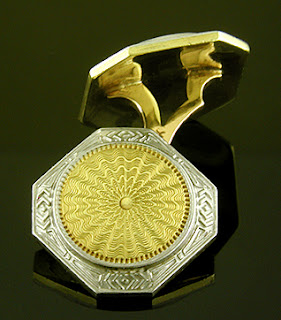The imagination and creativity of the cufflink makers of the late 19th and early 20th century is undoubted. A quick scan of the Antique Cufflink Gallery is all that is needed to confirm. What may be lesser known is that the same level of inventiveness and artistry is often evident in the linkages devised to hold the fronts and backs of the cufflinks together.
A hundred years ago cufflinks makers wrestled with two challenges: to create cufflinks that could be easily put on a cuff and that would also remain safely in place when worn. The inventive spirit of the age was brought to bear on this issue and a great variety of linkage designs and mechanisms was created. The striking Art Deco cufflink pictured offers an interesting example of linkage design. It was created around 1925 by the Richardson Manufacturing Co.
The linkage features a dramatically cut-out bridge that is hinged at one end and rigidly attached at the other. The hinged end allows the top of the cufflink to lie flush against the bridge as it passes through a button hole and the rigid end serves as a "push plate" allowing the wearer's thumb to help ease the cufflink through the cuff. As more angular, sometimes geometrically complex cufflinks came into fashion during the Art Deco era a little encouragement of the cufflink through the cuff was sometimes needed.
Once the front of the cufflink passed through the button hole, the top opened and lay flat against the cuff securely anchoring the cufflink in place. The design is both functional and aesthetically pleasing. The same careful thought that was applied to the design and crafting of the finely decorated tops was also applied to the linkages.

